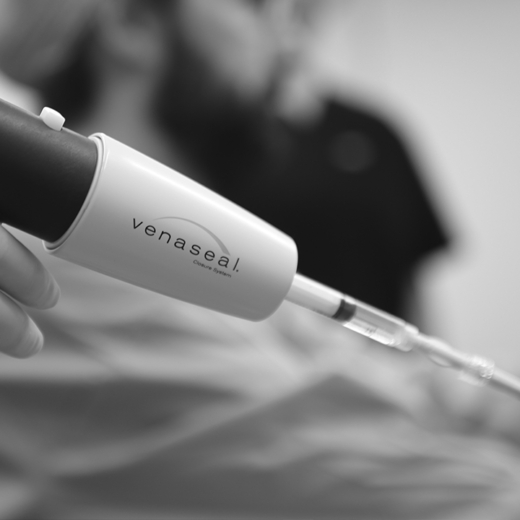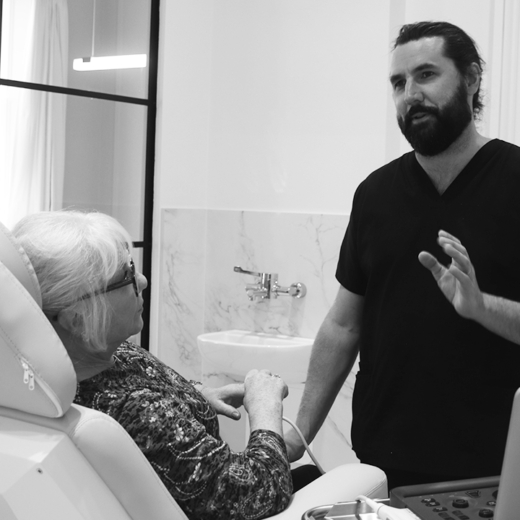McKeown Medical
167 Bath Street, Glasgow, G2 4SQ
The VenaSeal™ procedure is a minimally invasive varicose vein treatment that uses a special medical adhesive to close off the affected veins. Unlike other methods such as radiofrequency ablation or laser treatments, VenaSeal™ doesn’t require heat, tumescent anaesthesia, or multiple injections. This makes the procedure relatively quick and comfortable, with even less downtime and no need for compression stockings or bandages. You have the procedure, and walk out with no more than a small sticking plaster.
The VenaSeal™ procedure is a minimally invasive varicose vein treatment that uses a special medical adhesive to close off the affected veins. Unlike other methods such as radiofrequency ablation or laser treatments, VenaSeal™ doesn’t require heat, tumescent anaesthesia, or multiple injections. This makes the procedure relatively quick and comfortable, with even less downtime and no need for compression stockings or bandages. You have the procedure, and walk out with no more than a small sticking plaster.
Every patient is unique, and during our consultation process, we work with you to develop a bespoke treatment plan based on what you want to achieve.
1 hour
Local
None
Long term
From £3,750
The procedure is performed in an outpatient setting. First, your leg will be cleaned and sterilised, and a local anaesthetic is injected to the area where the catheter will be inserted. No tumescent anaesthesia (the injection of large volumes of diluted local anaesthetic) is needed, which reduces the number of needle sticks required.
Next, a catheter is inserted into the varicose vein from a tiny incision, usually near the knee or ankle. We do this under ultrasound guidance, to make sure the catheter goes in the correct place. The catheter is advanced through the vein to the point where the vein meets a deeper vein (such as the saphenous vein joining the femoral vein.)
Once your surgeon is sure the catheter is in place, the VenaSeal™ adhesive is delivered through the catheter in small, controlled amounts. Your doctor will gently apply pressure to the leg, ensuring the vein walls adhere to each other as the adhesive is released.
The adhesive seals the vein shut, preventing blood from flowing through it. This closure forces blood to reroute to healthier veins with functioning valves. The catheter is slowly withdrawn, delivering the adhesive along the length of the vein as it is removed.
The incision site is then covered with a small sticking plaster and thats you free to walk out. Patients can, and indeed should, walk immediately after the procedure and can return to normal activities virtually straight away. The main benefit of VenaSeal™ is that patients report less bruising, swelling and discomfort following treatment and can get back to normal activities even faster than with other endovenous procedures.
Dr Alex Vesey is our expert consultant vascular surgeon who heads up our varicose vein team. Listen to him explain the VenaSeal™ treatment.
Finding the right treatment for you is the most important factor in ensuring that you are on the correct path to achieve the results you desire. Our pre-consultation form helps us to identify your needs and, ultimately, gets you on the right path to achieving your optimal results.

We believe in clear, transparent pricing. We have no vague ‘from’ prices, that suddenly increase after your consultation. The prices here are accurate and reflect what you will pay for our level of expertise, technology and service.
One of the great benefits of VenaSeal™ is that there’s no need for compression stockings afterward, and most patients can return to their normal activities almost immediately.
In terms of aftercare, you may experience mild bruising, swelling, or tenderness around the incision site, which typically resolves within a couple of weeks. Pain is usually minimal and can be managed with over-the-counter pain killers like paracetamol if necessary.
It takes a while to see the benefits of the Venaseal procedure. Although the main vein is closed down at the time of the procedure, there is typically a period of several weeks of mild bruising and swelling and so most patients don’t see immediate benefits. Most patients start to see an improvement in their symptoms between 1 and 3 months after the procedure with results continuing to improve up to six months after the procedure.
Whilst the procedure is very effective at closing down the largest vessels, there are often smaller vessels that feed from the large vessels that take time to shut down or can persist after the procedure. It is normally possible to improve these smaller vessels with foam sclerotherapy or microphlebectomy. Most patients who have the VenaSeal™ procedure will also require one or two sessions of foam sclerotherapy to achieve optimal results.
Bruising, swelling and discomfort are common and to be expected after the procedure. Less commonly, phlebitis – or inflammation of the blood vessel – can become a problem that requires treatment with anti-inflammatory medication. Very rarely, an infection at the incision site can require additional treatment with antibiotics. Injury to nerves surrounding the blood vessel can cause temporary numbness or tingling. Deep vein thrombosis is the most serious complication, that affects between 1 in 100 and 1 in 1000 patients. This requires immediate medical attention to prevent it from progressing to a pulmonary embolism.
In addition to the VenaSeal™ procedure being even less invasive than other endovenous methods, and having lower risks of complications, the biggest attraction for most patients is that the recovery tends to be faster with most patients not being required to wear compression stockings.
The VenaSeal™ procedure is usually very effective, particularly for patients who have been properly assessed, diagnosed and had the correct treatment for their condition. However, a small percentage of patients – despite the best care and attention – will experience recurrence of the varicose veins. This is usually around 5%.
The key to achieving the best outcome when treating your varicose veins is to ensure you are treated by an experienced vascular surgery specialist that you feel you can trust and making sure you are properly assessed and have a bespoke treatment plan that you follow, including all aftercare instructions.

Our vascular surgery service is led by Dr Alex Vesey. Alex is a highly skilled vascular surgeon with extensive experience in diagnosing and treating a wide range of vascular conditions. With a focus on minimally invasive techniques, Dr. Vesey is dedicated to providing patients with the most advanced and effective treatments for venous diseases, with a particular interest in the treatment of varicose veins.

Our vascular surgery service is led by Dr Alex Vesey. Alex is a highly skilled vascular surgeon with extensive experience in diagnosing and treating a wide range of vascular conditions. With a focus on minimally invasive techniques, Dr. Vesey is dedicated to providing patients with the most advanced and effective treatments for venous diseases, with a particular interest in the treatment of varicose veins.
We offer a full range of treatments for varicose veins, each one tailored to your own unique circumstances.

When it comes to treating varicose veins, VenaSeal™ has emerged as a revolutionary option that offers a minimally invasive and...

Varicose veins are enlarged, twisted veins that often appear just under the skin, primarily in the legs and feet.
1 / 3
2 / 3
3 / 3

When it comes to treating varicose veins, VenaSeal™ has emerged as a revolutionary option that offers a minimally invasive and...

Varicose veins are enlarged, twisted veins that often appear just under the skin, primarily in the legs and feet.
Keep up to date with the latest news from McKeown Medical and get access to expert insights, our latest before and afters and exclusive offers.

